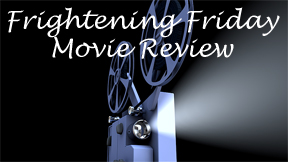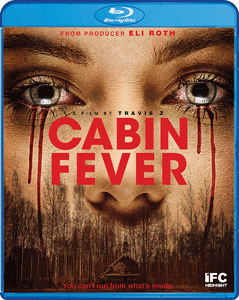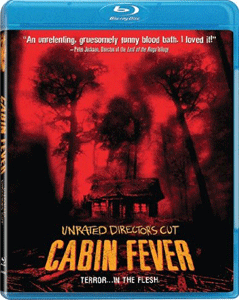“Cabin Fever” (2002 at festivals, 2003 wide release) is considered an important film in horror circles. It marks writer-director Eli Roth’s coming-out party and features gore-ific body horror at a time when such films were rare. Watched in the pandemic age, it’s more effective as contagion horror than it was then. But the low budget – and therefore low quality of acting, editing and music — remains a glaring weakness.
Failed attempt at weirdness
While Roth – particularly as a director – is clearly wading into a new craft, practical effects maestro Greg Nicotero adds professional cachet. He was well regarded among horror nerds at the time, and a decade later he became a household name with his work showcased weekly on “The Walking Dead.”
Tame by the standards of Roth (who would later be labeled a “torture porn” purveyor), “Cabin Fever” now stands out for its bad acting. Roth’s screenplay goes for the weird, wiggins-inducing type of backwoods horror a la “The Texas Chain Saw Massacre,” but he doesn’t have actors who can pull it off.

“Cabin Fever” (2003)
Director: Eli Roth
Writers: Eli Roth (screenplay, story), Randy Pearlstein (screenplay)
Starring: Rider Strong, Jordan Ladd, James DeBello
Our truckload of 20-something protagonists (Rider Strong, Jordan Ladd, James DeBello, Cerina Vincent and Joey Kern) comes upon a rest stop where a kid bites one of them. Later, a sheriff’s deputy (Giuseppe Andrews) likes partying more than doing his job; this character in particular is not remotely believable.
These odd backwoods folks are supposed to keep us off-balance. But the weak acting – plus daytime soap opera music during the sex scenes — only reminded me of the low budget.
Newfound relevance
“Cabin Fever” — which spawned two sequels and a remake — is sometimes categorized as a comedy. A closing bit with a seemingly racist shopkeeper who actually loves black people is definitely intended for laughs. Before that, I’m not sure if all the jokes are intentional.
That said, “Cabin Fever” is effective as a gory goof, and it gains an extra layer when one thinks about the coronavirus or monkeypox. Eventually, it’s clear the flesh-eating virus is transmitted by water, but before that the friends are fairly nonchalant about being close to their infected brethren. You might be tempted to yell at the screen.
Nicotero and company splatter enough blood across various surfaces – windshields, bathrooms, and fair amount of the woods – to make one uneasy. But I was always aware I was watching a movie. As such, “Cabin Fever” is a trifle. In the abstract, it’s surprising Roth’s screenplay was reshot in 2016. But after watching the original, I’m not surprised; it left room for improvement.
“Cabin Fever” (2003): 2.5 stars

A slight improvement
So how about that remake? Well, your enjoyment of “Cabin Fever” (2016) will depend on what you want from it. Near-shot-for-shot remakes are often loathed because most viewers want something new from a remake, and that’s notoriously the case with this one: It rates 3.7 on IMDb, down from the original’s 5.6.

But I watched it with an intrigued critical eye about the things it does better – of which there are several. Director Travis Zariwny’s remake is no masterpiece, but it is a technical improvement, and I’d recommend this version to a newcomer.
The superstar here is composer Kevin Riepi. You could put his music in place of the original’s generic track and vastly improve that film. He infuses the remake with tension and eliminates moments where we weren’t sure if we were supposed to laugh.

“Cabin Fever” (2016)
Director: Travis Zariwny
Writers: Eli Roth (screenplay, story), Randy Pearlstein (screenplay)
Stars: Gage Golightly, Matthew Daddario, Samuel Davis
For example, Riepi’s score ratchets up the beats during the first inline cut toward the victim’s ravaged skin, telling us to take this plague seriously. A setting of thicker woods for the climactic chase, and more rainfall and darkness overall, further helps Zariwny realize what Roth was going for.
More Rothian than Roth’s version
Erick Schiele’s special effects team doesn’t try to compete with Nicotero’s iconic shot of poor Karen’s face having been eaten away to the bone. But they deliver gorier effects overall, and one particularly torturous death, actually making the film more Rothian than the one helmed by Roth.
The main quintet (Gage Golightly, Matthew Daddario, Samuel Davis, Nadine Crocker and Dustin Ingram) is more polished than that of the original. The Karen-Paul relationship swaps out realistic awkwardness for traditional coolness from both of them, which is a loss for character depth. But the remake’s supporting cast is a huge improvement, with the gender-swapping of the deputy (Louise Linton) giving us a fresh take.
“Cabin Fever” 2016 is not precisely a scene-by-scene reshoot; it shuffles the narrative in the final act. That’ll be fun for people who willingly take this ride. But, as is always the case with projects like this, not everyone will want to.
“Cabin Fever” (2016): 3 stars

